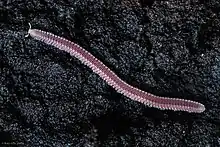Gosodesmus
Gosodesmus claremontus is a species of platydesmidan millipede, described by Ralph V. Chamberlin in 1922, that is widely distributed in the U.S. state of California. Individuals vary in color from bright pink to coral, and may possess a black or purple dorsal stripe. Body length ranges from 17 to 27 mm (0.67 to 1.06 in), with up to 81 body segments. Gosodesmus occurs on the Coast Ranges as well as the Sierra Nevada, and is often found within rotted wood, especially oaks.[2][3]
| Gosodesmus | |
|---|---|
 | |
| Scientific classification | |
| Kingdom: | |
| Phylum: | |
| Class: | |
| Order: | |
| Family: | |
| Genus: | Gosodesmus Chamberlin, 1922 |
| Species: | G. claremontus |
| Binomial name | |
| Gosodesmus claremontus Chamberlin, 1922[1] | |
| Synonyms | |
|
Eucybe clarus Chamberlin, 1941 | |
References
- Chamberlin, Ralph V. (1922). "A New Platydesmoid Diplopod from California". Journal of Entomology and Zoology. 14: 10–13.
- Buckett, John S., and Michael R. Gardner (1969). "A Review of the Genus Gosodesmus Chamberlin, with the Synonymy of Eucybe Chamberlin (Diplopoda: Platydesmida: Andrognathidae)". Journal of the New York Entomological Society. 77 (1): 40–50. JSTOR 25006146.CS1 maint: uses authors parameter (link)
- Gardner, Michael R. (1975). "Revision of the millipede family Andrognathidae in the Nearctic region (Diplopoda, Platydesmida)". Memoirs of the Pacific Coast Entomological Society. 5: 1–61.
This article is issued from Wikipedia. The text is licensed under Creative Commons - Attribution - Sharealike. Additional terms may apply for the media files.